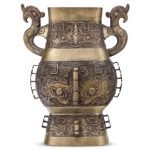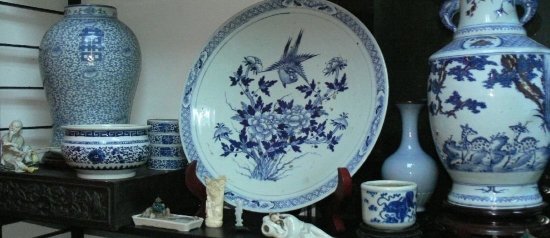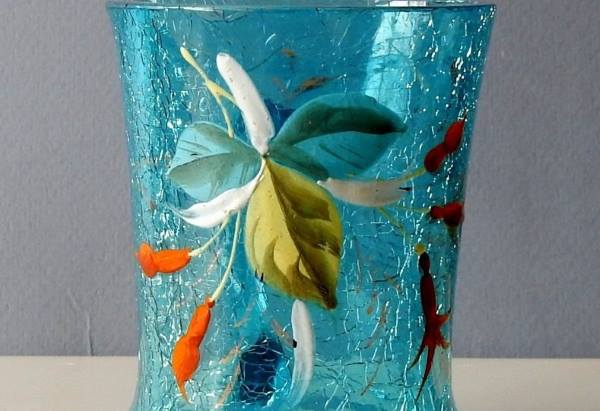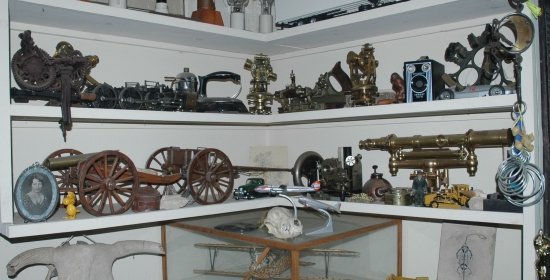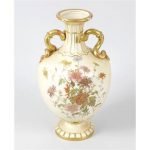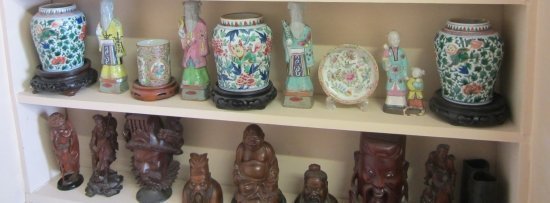As collectors of Japanese ceramics know, most of what used to be called ‘Ko-Kutani (old Kutani) ware’-early Japanese porcelain with darkish overglaze enamel decoration-is now catalogued as ‘Arita ware, Ko-Kutani style/type’. This new term applies to a square porcelain bottle with a design of landscape and flowers in the Art Gallery of New South Wales.
This was a major change, as it all but stripped the old Kaga province (present day Ishikawa prefecture) of its title as producer of many celebrated porcelain pieces. Given the Japanese passion for their ceramics, such a change did not occur without commotion. I was fascinated by the process that brought about this change, and this is a brief account of it.
Until the twentieth century, knowledge of ceramics belonged to the realm of connoisseurship. Major changes to this attitude occurred in the Taisho period (1912-26). With a revival of Momoyama period ceramics, for instance, artist-potters began looking for old kiln sites in search of the right clay in their efforts to recreate the forgotten colours and textures of various Momoyama ceramics. In 1914, scholars from Tokyo University led by Okochi Masatoshi and Okuda Seiichi, formed the Saikokai (Coloured Jar Society), a ceramics study group aimed at obtaining objective knowledge of ceramics.1
Saikokai thus laid the foundation of modern scholarship in ceramics studies. It was this group that named the early Japanese porcelain with its characteristic darkish overglaze enamel colouring (green, blue, brown, yellow and purple) and bold Ming-style designs, a large part of which was found in Kaga province, as Ko(old)-Kutani ware. The word ‘old’ was used because its production ceased around 1700 and it was necessary to distinguish it from later ceramics produced in the region since its revival in the late Edo period (early nineteenth century). According to Shoichi Narasaki, over 10,000 pieces of Ko-Kutani ware survive today including some excellent examples.2
Naturally, the people in the Kaga region were always proud of their ceramics tradition. Since the nineteenth-century revival, potters have produced porcelain in the traditional Ko-Kutani style. Meanwhile in Arita, the birthplace and the largest production centre of Japanese porcelain in the north of Kyushu (the southern island), the potters had believed that the Kakiemon style was the first of the porcelain decorated with overglaze enamel.
Doubts on the origin of Ko-Kutani ware were voiced before the War with little consequence. What turned murmur into audible voices was a text originally written by an English scholar. In 1956 Soame Jenyns, a scholar of Japanese ceramics at the British Museum, wrote a catalogue essay for an exhibition of Japanese ceramics held by the Oriental Ceramics Society in London. In the catalogue, Jenyns suggests that most of the pieces classified as Ko-Kutani ware (for their colour and design) in Europe were in fact made in Arita, because ‘most of the Japanese porcelain which has found its way to Europe was imported in the latter part of the seventeenth century and is usually either Kakiemon or Imari porcelain, the product of the Arita kilns.’ And he wonders if a ewer in the exhibition from the de la Mare collection, with a silver mount inscribed with the date 1671, might be one of them.3
Jenyns’ text was translated the same year into Japanese and published in the ceramics magazine Tosetsu, accompanied by a reproduction of the de la Mare ewer he mentioned.4 The Dutch East India Company, exporter of Arita porcelain through the port of Imari, is unlikely to have purchased porcelain produced in the Kaga district of central Japan, at much higher prices due to an added cost of transport. The possibility that so-called Ko-Kutani ware was in fact produced in Arita became strong.
In his article, Jenyns does not cast doubt on the belief that Ko-Kutani ware was made in Kaga. He suggests that so-called Ko-Kutani pieces in Europe such as the de la Mare ewer were possibly Arita copies of Ko-Kutani ware.
The next major article to contribute to the debate appeared in the magazine Tosetsu five years later, written by Yamashita Sakuo. He points out that sherds of the so-called ‘Suisaka type’ of Ko-Kutani, believed to have been produced at Suisaka village in Kaga, were not found at old Suisaka kilns when they were excavated ten years earlier. On the other hand, many Suisaka sherds were found in Arita during a recent building excavation. Yamashita proposes that Arita was the actual birthplace of many pieces classified as Ko-Kutani ware.5
Lively debate sprang up. Some scholars avoided the debate altogether, but others persisted in their theories. The debate prompted major excavations of Ko-Kutani kilns in 1970-71, led by two leading ceramics experts, Professors Mikami Tsugio and Narasaki Shozo. These excavations did not produce positive evidence that Kaga was the main producer of Ko-Kutani. Mikami presented the results of the excavation at a major international conference held in 1972 at Seattle Art Museum. At the conference, Soame Jenyns was inclined to agree with Yamashita and others in thinking that most ‘handed-down Ko-Kutani’ pieces were of Arita origin, made before the Kakiemon style appeared.6 From a historical viewpoint, it would make more sense that the highly refined Kakiemon-style overglaze enamel ware was preceded by the less sophisticated Ko-Kutani style, rather than the Kakiemon style suddenly appearing after blue-and-white early porcelain.
In Japan, however, there was strong resistance to change. Not only local pride but also the antique ceramics market would be affected by the outcome of the debate, as Ko-Kutani ware was rarer and would fetch higher prices. At a symposium on Ko-Kutani ware in Japan held in 1976, opinions were still very much divided. While admitting that the small kilns in Kaga could not have produced so many porcelain pieces that still exist, some conservative scholars suggested that Arita bodies were brought in to Kaga to apply overglaze locally.7
In the following decade or so, many excavations of Arita kilns took place and more Ko-Kutani style sherds were unearthed. That the old Kaga kilns produced Ko-Kutani ware was also confirmed. However, as more and more existing masterpieces were confirmed to have been produced in Arita, Hayashiya Seizo and Narasaki first replaced the term ‘Ko-Kutani ware’ with ‘Arita/Imari ware Ko-Kutani style’ for those pieces in their 1984 publication in the World Ceramics series, published by Shogakukan. In 1991, the authoritative Toyo Toji Gakkai conference overwhelmingly adopted the Ko-Kutani=Arita theory, and the Tokyo National Museum changed its display labels in 1994.
Although the change of labelling seems to have taken a long time, one may argue that the passionate resistance to change of the old Ko-Kutani=Kaga theory in fact contributed to the advance in ceramics research during the last three decades, involving scholars, connoisseurs and archaeologists, to the benefit of collectors around the world.
Footnotes
1 Saikokai was discontinued after the Great Kanto Earthquake of 1923. It was then restarted as the Toyo Toji Kenkyujo (Asian Ceramics Research Centre), then the Toyo Toji Gakkai (Asian Ceramics Society) was formed with a wider membership in 1973.
2 Shoichi Narasaki, ‘Kutani koyo-no chosa seika’ in Toyo Toji, vol. 20/21, 1992, p. 103.
3 Catalogue of an exhibition of Japanese Porcelain, Oriental Ceramic Society, London, 1956 (no page numbers).
4 Tosetsu, no. 40, July 1956, pp. 11-20; no. 41, August 1956, pp. 16-23. Tosetsu is published by the Japan Ceramics Association and is widely read by ceramics collectors and connoisseurs. It is a major source of material I have used.
5 Tosetsu, no. 124, July 1963, pp. 11-17.
6 International Symposium on Japanese Ceramics, Seattle Art Museum, 1973, p. 140.
7 Narasaki, 1992, p. 104.


